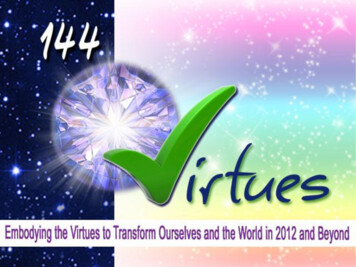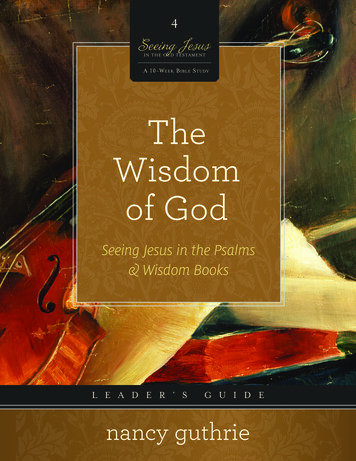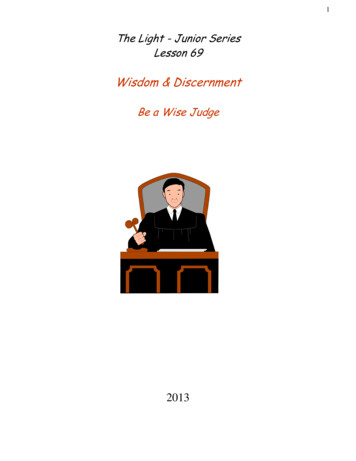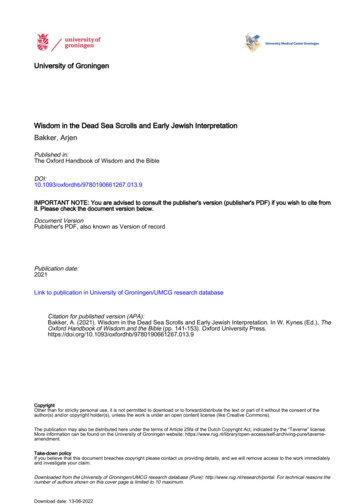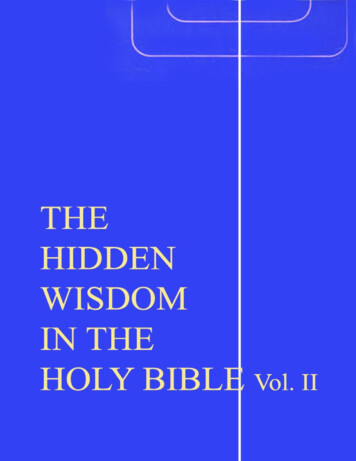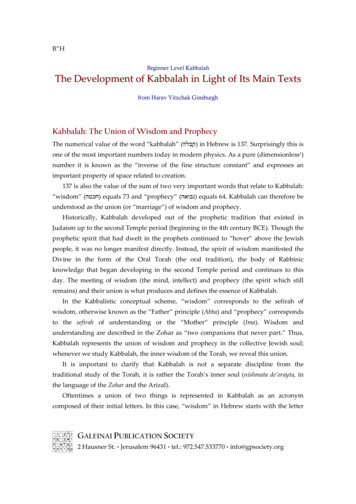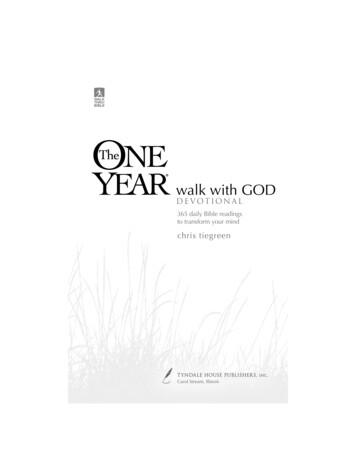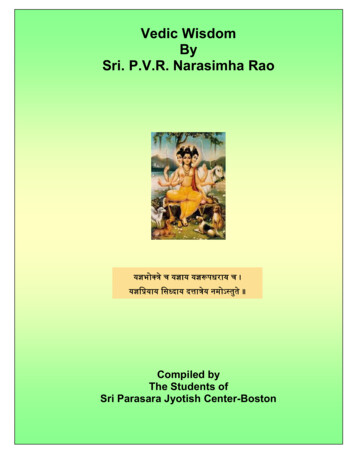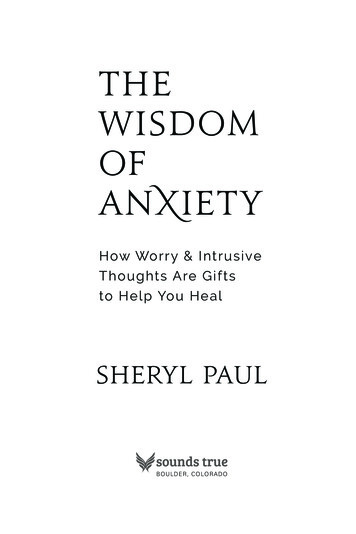
Transcription
TheWisdomofAnXiet yHow Worry & Int r u s i veThoughts Are G i f t sto He lp Yo u He a lSheryl PaulBOULDER, COLORADO
IntroductionANXIETY IS A DOORWAYCarl Jung said that if you find the psychic woundin an individual or a people, there you also findtheir path to consciousness. For it is in the healing of our psychic wounds that we come to knowourselves. . . . In the evolution of consciousness, ourgreatest problem is always our richest opportunity.ROBERT JOHNSONWe: Understanding the Psychology of Romantic LoveAnxiety is the wound of our times. According to the WorldHealth Organization, 260 million people are diagnosed withanxiety worldwide — and millions more are without a diagnosis. These numbers clearly indicate that we are living in an age ofanxiety. This profound psychic wound crosses all boundaries by whichwe typically classify ourselves, for anxiety, like loss, is one of the greatequalizers: it doesn’t matter how old you are, where you live, what youlook like, how much money you make, your sexual orientation, or yourgender — eventually everyone will meet anxiety in the dark of night.While the nature of the wound is clear, what is less clear from amainstream perspective is how to address it. Guided by a Westernmindset that seeks to erase pain in all forms (physical, emotional,mental, and spiritual), most people see anxiety and its cohort of symptoms as something to hide, deny, distract from, or eradicate. Whatwe don’t realize is that when we regard anxiety only as a problem andseek to eliminate the symptoms, it is pushed underground, where it’s1
THE WISDOM OF ANXIETYforced to rise back up with greater intensity, and we also miss the richopportunity to evolve both individual and cultural consciousness thatanxiety invites.For anxiety is both the wound and the messenger, and at the coreof the message is an invitation to wake up. In order to decipher thespecifics of its messages, we have to shift from a mindset of shame,which sees anxiety as evidence of brokenness, to a mindset of curiosity, which recognizes that anxiety is evidence of our sensitive heart,our imaginative mind, and our soul’s desire to grow toward wholeness.Anxiety, when approached from the mindset of learning, directs youto something deep inside that needs to be seen, a call from soul to payattention, an invitation from the wellsprings of being to turn inwardand heal at the next layer of growth.One element that reduces the shame around anxiety is knowingthat you’re not alone; normalization causes shame to shrink. From thecross section of my worldwide audience, I hear the same symptomsand thoughts: “What if I married the wrong person?” “What if I havea terminal illness?” “What if I run out of money?” “What if something horrible happens to someone I love?” “What if I hurt my baby?”These are all clues that anxiety is the wound of our times and thatwe’re in the territory of the collective unconscious. Carl Jung coinedthe term “collective unconscious” to describe the part of the mindthat is common to all humans; and these thoughts, emerging from ashared psyche, point to the archetypal themes and stories where anxiety constellates: relationships, health, money, parenthood, the need forsafety and security. Over the years, clients have shared these thoughtsin hushed tones, but because I write about them weekly on my blog,they know that they’re not alone. One of the blessings of the internetis that the contents of the collective unconscious, formerly only accessible via dreams and myths, are now more widely accessible. You are farfrom alone with your anxiety, no matter how it manifests.Anxiety’s emissaries arrive in many forms: worry, intrusive thoughts,obsessions, compulsions, insomnia, somatic symptoms. If we greetthese emissaries with shame and try to sequester them into the fardown, hidden recesses of psyche, they will gather in numbers and2
ANXIETY IS A DOORWAYstrength until we are forced to listen. As they scream for attention, theculturally induced, shaming voices take over and say, “You’re broken.You’re fundamentally wrong. These thoughts and symptoms are evidence that there’s something deeply, pathologically wrong with you.Don’t talk about. Don’t admit it. Try to get rid of it as quickly andcleanly as possible.”Seeing anxiety and intrusive thoughts as wise manifestations of theunconscious is a vastly different view — and a much more hopeful andlife-enhancing view — of anxiety than the one our culture holds. Forwhat I’ve witnessed over the last twenty years of working closely inthe underworld of psyche is that when we turn toward our symptomsinstead of medicalizing and pathologizing them, we begin to gatherour gold. Anxiety is a doorway into a self that longs for wholeness.Our symptoms, when honored, lead the way. When you meet yourdarkest, most uncomfortable places with a mindset of curiosity andcompassion, you transform, and your life expands in untold ways.I’ve seen it countless times with my clients, my course members, myfriends, my children, and in my own life. The same can be true for you.Brazil: My Initiation into AnxietyThere were several pivotal events in my life that invited me to realignwith my soul, times when my inner self grabbed me by the anklesand dragged me into the underworld. The first, and most powerful,was a panic attack that broke me open when I was twenty-one, a fewmonths before I graduated from college. It was that panic attack andthe subsequent years of drowning in daily anxiety that shattered myillusion of my “perfect life.” It destroyed my glass castle of superiority, the belief that I was beyond suffering, created and confirmed byyears of immersion in an education system that rewarded me for beingschool-smart. It destroyed my conviction that I had the right answers,or any answers. In short, it brought me to my knees in all ways — fromheart palpitations to a phobia of driving that ensued after that firstpanic attack to night terrors and nightmares that punctuated my sleepfor years. And yet, from the ashes, the pain, and the total destruction3
THE WISDOM OF ANXIETYof life as I had known it, a new life — and a life’s work — was born.This is how our unconscious, working through anxiety and its sisterhood of symptoms, invites us toward wholeness: we’re broken open,brought to our knees, dragged into the underworld not to be torturedor because there’s something wrong or disordered with us, but becausethere’s something right and beautiful inside that is longing to be seenand known.The seeds of my panic attack had been planted a year before and wereintimately connected to a trip to Brazil my junior year of college. I neverplanned to go to Brazil. Having spoken Spanish throughout high schooland into college, I had always planned to travel to Spain. But then theBrazil bug bit me: I had taken a Brazilian dance class the summer aftermy first year of college, and I was hooked by the dance and the culture.I danced all summer. I danced through the next year and immersedmyself in Brazilian music. Quite impulsively, I changed my plans and setinto motion an experience that would alter the course of my life.In January 1990, instead of getting on a plane to Spain, I headedfor Salvador, Brazil, where I was immediately pummeled when thefantasy I had built up in my mind clashed hard with the reality Iencountered. In a single moment, I was yanked from my safe, clean,upper-middle-class life and hammered down into the middle of a life Ihad never known on any level. I lived in favelas where cockroaches thesize of snails lined the floors and ceilings in such numbers that whitepaint seemed black; I witnessed a man get shot during Carnival; I dailywalked past pools of fresh blood on the streets; I nearly drowned in asudden riptide; I had trouble finding anything healthier than Guaranáto drink (basically sugar water). For months, I ate what I thoughtwere crushed peanut cakes from vendors on the side of the road onlyto learn at the end of the trip that they were actually crushed shrimpcakes that had been sitting in the hot sun all day. All my systems, fromthe physical to the spiritual, were on high-alert overload.Those four months terrified me, yet they were also what initiatedme into an essential breakdown that would lead to following the breadcrumbs of anxiety and panic into my true self. Some people are initiated through ancient rites in the middle of a forest. Some people are4
ANXIETY IS A DOORWAYinitiated through a crisis of health, relationship, or faith. I was initiated in Brazil. And when I look back now, I can clearly see that I waspulled to Brazil by invisible forces: the dance, the music — somethingunnamable led me there. It was out of character for me to be so impulsive, but nothing was going to stop me; I had to go. I had to be brokenopen. The story of my life as I had known it — that I was somehowabove suffering — had to shatter so that the underworld of hidden painthat lived inside the polished persona could emerge and be healed.We’re all offered experiences that break us open to our core. Oneof the fatal flaws of our culture is that we take everything at face valueand fail to see the metaphor, which, itself, contains the keys to healing.When a client comes to me convinced that he has cancer, regardless ofthe fact that he received a clean bill of health the week before, it takestime to quiet the ego’s convincing story enough to explore the deeperunderpinnings that are longing to be known. If we remain attached toaddressing the anxiety at the level of the story — which usually lookslike seeking endless reassurance — we’ll remain stuck in anxiety. But ifwe can crack open the story and see that the fear of cancer, for example,is pointing to a need to develop tolerance for uncertainty and explorethe metaphor that something is “eating away” at one’s heart or soul,shifts begin to occur.In my story, Brazil wasn’t the problem. In fact, it took me years tounderstand that Brazil was the screen onto which my own unworkedshadow — the pain, fear, and trauma that had to be shoved down inmy first twenty years in order to keep going — was projected. BecauseBrazil carried my shadow, I couldn’t see its beauty; I only saw the terrorand despair that lived inside of me reflected in my surroundings. Andit took having a panic attack while driving down the 405 freeway inLos Angeles for the shadow to rise to the surface where I could finallysee it, work with it, and heal.The ensuing years, which were the decade of my twenties, were bothpainful and transformative. In my early twenties, I entered a graduateprogram in depth psychology, which helped me begin to make sense ofmy anxiety through the lens of Jungian theory, which understands thatsymptoms are messengers from the unconscious, inviting us to grow5
THE WISDOM OF ANXIETYtoward wholeness. In my midtwenties, after working with a series ofmediocre therapists, I landed on the couch of a brilliant man whoguided me through the terrain of anxiety and helped me navigate myinner landscape. I read voraciously about transitions and wrote my firstbook, The Conscious Bride, which explores the underbelly of the wedding rite of passage. I began to work with clients struggling throughtheir own transitions, especially around relationships, and helpedthem understand the invitations and metaphors embedded in theirpresenting stories.None of this would have happened without Brazil. For years Iregretted that experience, until eventually I realized that Brazil was mysoul’s way of forcing me to grow. It wasn’t an accident; and your lifeisn’t an accident either — not your anxiety, your wounds, your failures,or your traumas. In fact, the great sages teach that the seed for healinglives at the center of each trauma, meaning that your greatest challengewill also be your greatest strength. When I look back on Brazil, I knowthat it was through that experience that my inner world demanded tobe known. Anxiety and panic were the doorways that led me to peelaway the layers of pain and adapted persona that needed to be shed sothat I could live closer to my true self. Anxiety is your doorway, too.A Road Map Through AnxietyThis book will guide you step-by-step through the necessary mindsetsand tools that will help you transform your relationship to anxiety so thatyou can release yourself from its grip and learn to decode its messages.In part 1, I will clearly define anxiety and its symptoms as wellas articulate the origins and causes of anxiety. I discuss the three pillars that allow the sensitive soul — and what I’ve come to see over theyears of working with thousands of people is that we are all, to varying degrees, sensitive souls — to navigate successfully through life:understanding who you are and how you’re wired, understanding howtransitions are crucial breaking and renewal points that can eithercalcify or heal layers of anxiety, and offering the foundational keysof curiosity, compassion, stillness, and personal responsibility, which6
ANXIETY IS A DOORWAYallow you to transform anxiety from a burden to a gift. I will also discuss the most challenging roadblock that appears anytime we set outin the direction of healing: resistance.In part 2, I will guide you through the four realms of self — body,thoughts, emotions, and soul — so that you can learn to decipherthe messages embedded in each realm. My work is holistically based,which means that, while most approaches address anxiety from a physical (somatic healing), emotional/psychological (some talk therapy), orcognitive (behavioral therapy and most talk therapies) perspective, mywork encompasses all three of these areas plus a fourth: our soul. AsI view anxiety not as something to get rid of but as a call for healing,part 2 will help you understand that anxiety is a messenger that ispointing to unmet needs and unhealed places in all four realms.In part 3, I will explore how anxiety shows up in your intimaterelationships with friends, partners, and children. Because our culturesends the erroneous message that fear and love are mutually exclusiveand doesn’t understand the paradoxical nature of love in all forms,when anxiety appears in our relationships, it’s easy to believe thatthere’s something wrong. This section explodes that belief and replacesit with a model that supports healthy love and mindful parenting sothat we don’t allow shame and anxiety to tear at the fabric of our mostsacred and meaningful relationships.In each section, I’ll share stories both from my clients’ experiencesand moments of my own life that highlight how to sink below thesurface of anxiety and tap into the wellsprings of wisdom that it offers.These stories will teach in a spiral as opposed to a linear fashion, meaning I’ll write about tending to grief in the chapter on transitions andreference back to transitions when talking about grief. Despite whatthe culture teaches, learning isn’t linear, but follows the circular, spiralrhythm of the soul. This book, while organized into chapters, followsthe soul rhythm as well.Throughout the book, I’ll be offering both on-the-spot practices anddeep-dive practices for healing from anxiety. On-the-spot practices areactions you can take in the moment, anywhere, at any time: in a meeting, on the elevator, in the airplane, at a party, in bed at night. They7
THE WISDOM OF ANXIETYwon’t heal the anxiety from the root, but they’ll help you move througha high-anxiety moment and will also help you take anxiety a few notchesdown in general so that you can engage in the deeper practices.The deep-dive practices are those that will heal anxiety from theground up and help you decipher its messages. These are practicesthat I’ll be encouraging you to engage with every day, preferably whenyou first wake up in the morning (before you grab your phone) andat night before you go to sleep. As you read through the pages ofthis book, you will glean a lot of information about the roots of youranxiety, and this information will likely translate into personal insight.Write down these aha moments as they arise, either in the marginsof this book or in a journal. Then use these insights as springboardsfrom which to engage regularly with the deep-dive practices. Insightis essential, but it’s action that metabolizes the insight into your bodyand heart and result in change. It’s a simple formula: insight action change. If you want to break free from anxiety, practice is key.While all the tools are designed to be practiced on your own, innerwork is infinitely more effective when we’re witnessed and guided bya skilled professional. As such, if you’re not currently in therapy, Irecommend finding a therapist who can work alongside you on thisjourney. Throughout history, humans have sought counsel from mentors and shamans, religious figures and teachers, and for many modernpeople, therapists fill those roles. We are not meant to figure life outon our own. Also, don’t hesitate to share this book with your therapist. While they will have their own model and mindset from whichthey work, good therapists will always be open to learning new philosophies and tools that might help their clients, and possibly eventhemselves, grow and heal.Key Terms on the JourneyIn order to decipher anxiety’s messages, it’s helpful to understand theprimary vessels through which anxiety communicates, so I’ll definehere the terms that you’ll be encountering throughout this book.8
ANXIETY IS A DOORWAYSoul. Our guiding principle. Jungian theorists refer tothe soul as the Self with a capital S, and it is another wordfor the unconscious. We connect most deeply with thisaspect of ourselves through dreams and symptoms, and it’sthis inner guide that presents the symptoms that we’ll bediscussing throughout this book — anxiety, rumination, worry,intrusive thoughts, insomnia — as it attempts to bring usback into alignment with our core essence. Psyche, anotherterm you’ll find in this book, is another word for soul. Infact, in Greek mythology, Psyche is the goddess of the soul.Spirit. The connecting energy or source that is both insideeach of us and beyond us. We connect to spirit most oftenthrough creativity, imagination, nature, meditation, the arts,animals, and prayer. We feel spirit at the birth of a child, atweddings, while standing at the base of giant redwoods or onthe shores of the ocean. Some people connect to spirit in areligious context, but many people connect to this animatingprinciple in ways that have nothing to do with organizedreligion. Joseph Campbell describes it as “the generatingenergy of the life that is within you and all things.” In itssimplest definition, spirit is interchangeable with love.Ego. The ego, which simply means “I” in Latin, is thepart of ourselves that is conscious and of which we areaware. As Robert Johnson writes in Inner Work,When we say “I” we are referring to only that smallsector of ourselves of which we are aware. Weassume that “I” contains only this personality, thesetraits, these values and viewpoints that are up on thesurface within the ego’s range of vision, accessible toconsciousness. This is my limited, highly inaccurateversion of who “I” am.9
THE WISDOM OF ANXIETYThe ego is our conscious self and is a necessary and healthypart of our psychological structure, but it also includes thefear-based parts of our personality. The ego includes ourconscious aspects — both the ability to think, feel, reflect,plan, and execute, and the part of us that feels so comfortablewith what we know (conscious awareness) that it resists theunknown realm of the unconscious. When we believe thatwe are only our conscious/ego selves, we lose touch with theguiding principle of our lives, which is our soul/unconscious.Resistance. Ego has many subsets, including resistance, whichis the part of us that is scared to grow because it fears change.Resistance clings to the status quo and often shows up aslaziness, inertia, numbness, and fear. In order to gather thegifts of anxiety and grow to our next level of consciousness,we have to work actively with resistance so that it doesn’t runthe show. The paradox of the ego is that it both resists growthand longs to be in relationship to the soul. Part of the tensionof being human is being in relationship with this paradox.Individuation. Robert Johnson explains in Inner Work that“individuation is the term Jung used to refer to the lifelongprocess of becoming the complete human beings we wereborn to be. Individuation is our waking up to our total selves.”The process of individuating includes shedding aspects of theconditioned personalities that we absorbed through the processof growing up but that are not in alignment with our true selves.For example, if a child grows up to become a doctor toplease her parents, but deep inside her passion lies in animalcommunication, when she’s broken open through anxietyor during a transition, she will have been invited to shed atleast one layer of the need to please her parents, which willallow her to come closer to her true self. Every time we walkthrough a transition consciously, as we’ll see later in the book,we have an opportunity to shed a layer of our conditioned10
ANXIETY IS A DOORWAYmindsets, habits, beliefs, and intergenerational patterns thatno longer serve us. Anxiety and its attending feelings that ariseduring transitions and at other times in life are the arrowsthat point the way along the journey of individuating.Anxiety is the bridge that connects ego to soul, conscious to unconscious, and when we learn how to harness the wisdom of anxiety, therichness and messages contained in the unconscious can inform andexpand our conscious lives.A Call to GrowAnxiety asks you, dear reader, to embrace the gift of who you are.Maybe you’ve been told that you’re too much — too sensitive, too dramatic, too emotional, too analytical — and this message was translatedinside your young self to mean that you were wrong or broken in someway. But you must begin to know now, as hopefully you will as youread through this book, that there’s absolutely nothing wrong withyou. You’re not broken. You’re not too much. You’re not wrong. In fact,it’s the very qualities that you’ve been shamed for that you now need towrap up like a hurt animal and hug close to your heart. For it’s whenyou stop seeing your sensitivity as a burden and instead recognize it asthe gift it is that you will begin to heal the hurt places inside you andbring your full presence into the world.The self-protective habit you’ve learned is to ignore the anxiety atbest and judge it at worst. Bereft of tools that teach you to movetoward your discomfort and encouraged by a culture that is externallyoriented — where your self-worth is correlated to external factors likeappearance, career status, financial assets, and achievements — you’vedeveloped an ingrained habit to track outward toward anything thatwill distract from or numb the pain. You may reach for external addictions like a digital device, a shopping spree, a drug, or staying busythrough Googling, Facebooking, working, advancing, climbing theladder, or to internal distractions like worry and intrusive thoughts.You so desperately want to avoid the “fundamental groundlessness of11
THE WISDOM OF ANXIETYbeing,” as Pema Chödrön refers to a basic aspect of being human thatfeels out of control as it knows that our lives are informed by constantchange and loss. The groundlessness is the sadness you feel around thepassage of time, knowing that life is always in transition. The groundlessness is the fear of big feelings since nobody taught you how to tendto them with kindness. The groundlessness is the nameless fear, grief,and dread that often accompany anxiety. Conditioned by a culturethat pounds you with the belief that the answers are “out there,” younaturally reach outward to stave off the discomfort of your inner world.But when you find the courage to turn inward, to become curious about the labyrinths and caves that make up your inner world,everything changes. You discover that anxiety can inform your life,but it does not have to define it. You’re not destined for anxiety; you’redestined for equanimity. You’re not destined for limitation; you’re destined for greatness. You’re not destined to feel lost, empty, and alone;you’re destined to feel purposeful and connected. You’re not destinedto define yourself by your challenges; you’re destined to grow throughthese challenges and become a more balanced version of yourself,where your weaknesses become your strengths, and the places whereyou’ve struggled most become your greatest gifts.A library as big as the universe lives inside you, waiting for you tosit down in some dimly lit, quiet corner so that you can discover itscontents. Are you ready to step inside, to unlearn much of what you’veabsorbed, and learn some basic principles of life and relationships thatwill fundamentally alter your understanding of yourself and the world?Are you ready to travel through the passageways of your four realmsof self — body, mind, heart, and soul — to heed the messages that liveinside each one? If so, take my hand, and let’s begin.12
our imaginative mind, and our soul's desire to grow toward wholeness. Anxiety, when approached from the mindset of learning, directs you to something deep inside that needs to be seen, a call from soul to pay attention, an invitation from the wellsprings of being to turn inward and heal at the next layer of growth. One element that reduces the shame around anxiety is knowing that you're .


